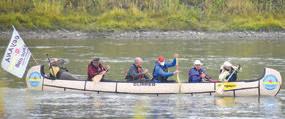
5 minute read
Canadian Heritage Rivers System Plaque Unveiling and Flag Raising Ceremony Held at Metis Crossing

Canadian Heritage Rivers System Plaque Unveiling and Flag Raising Ceremony Held at Metis Crossing
Michelle Pinon - News Advertiser
More than 50 people gathered at the Metis Crossing cultural interpretive centre on Sept. 12 to partake in the special ceremony.
Shortly after 2 pm Smoky Lake County Planning and Development Manager Jordan Ruegg welcomed everyone. “I am both honored and humbled to serve as the Master of Ceremony today as we mark this special occasion.

We are gathered here today to celebrate the recognition of the North Saskatchewan River as a Canadian Heritage River, a designation that honors the river’s unique cultural, recreational, and natural values.
We also gather today to witness a special Indigenous flag-raising ceremony, which is to acknowledge the rich history of both Treaty 6, and the Métis Nation.”
The North Saskatchewan River is a traditional gathering place, travel route, and home to Indigenous peoples including the nêhiyawak (Cree), Niitsitapi (Blackfoot), Ktunaxa, Métis, Nakota Sioux, Iroquois, Dene, Ojibwe, Saulteaux, Anishinaabe, Inuit, and Assiniboine. For centuries, the river was a transportation and trade route, first for Indigenous peoples, then settlers and explorers coming from the east to the Rocky Mountains and to the west coast. It played a pivotal role in the fur trade, early scientific expeditions, human settlement patterns and agriculture. Today, the river continues to provide an important source of drinking water, habitat for plant and animal species, and support for the tourism and recreation industries.
A 49-kilometer segment of North Saskatchewan River within Banff National Park was designated as a Canadian Heritage River in 1989. The final remaining 718 km section of the North Saskatchewan River within Alberta was initially nominated by Smoky Lake County in 2019 for its outstanding cultural and recreational values. The designation was accepted and officially announced on March 22, 2024 (World Water Day).
Ruegg said, “It is important to note that today we are also gathered within the Victoria District National Historic Site of Canada, which encompasses more than 10,000 acres of land comprised primarily of river lots intersected by the Victoria Trail.
The District was designated as a National Historic Site in 2001, largely thanks to the efforts of the Victoria Home Guard Historical Society.”
Ruegg introduced special guests before the official land acknowledgement was recited. Elders Jo Ann and Dr. Jerry Saddleback offered a special blessing and prayer.
There were several speakers throughout the special ceremony, including Senator Paula Simons, who delved deeper into the story of the North Saskatchewan River.

Smoky Lake County Reeve Jered Serben also addressed the crowd, stating, “Smoky Lake County is thrilled to share in the unveiling of these commemorative plaques, which recognize the iconic cultural, environmental, and recreational heritage of this place…This designation as a Canadian Heritage River brings with it a renewed focus on conservation and sustainable management. It is a testament to the collective efforts of our community, local organizations, and the many individuals who have worked tirelessly to ensure that this river remains a vital part of our heritage.
Following the unveiling of the plaques, Project Lead Kyle Schole shared some of his insights about the initiative. When I first brought this potential undertaking to Jordan on a rainy September day about five years ago, I don’t think either of us, nor our boss at the time, the late Cory Ollikka, fully appreciated what a journey we were about to embark upon.
The North Saskatchewan River has long been a vital artery for our region and province, influencing its development, culture, and communities.

These plaques are about more than some pieces of bronze and rock; it is a symbol of the enduring relationship between this river and the people who have lived beside it for centuries.
The text on this plaque will celebrate and immortalize the significance of the North Saskatchewan River. It acknowledges the river’s historical, cultural, and ecological importance and recognizes the ongoing efforts to protect and sustain it for future generations.
Indeed, today’s ceremony is not the end of this work, but only the beginning of its next chapter.”
Schole told the News Advertiser there will be more opportunities in the future with smaller rural communities such as Smoky Lake and others pooling resources to mapping up and down the river and planning canoe routes, smart signage for visitors and considerations for emergency services.
In respect to the Municipal Controlled Corporation, Schole said, “The partnership with town, county and Metis Nation of Alberta is going to be doing direct investment and developing new tourism products. So, it’s not just about marketing, it’s about supporting small businesses getting started as well.”








